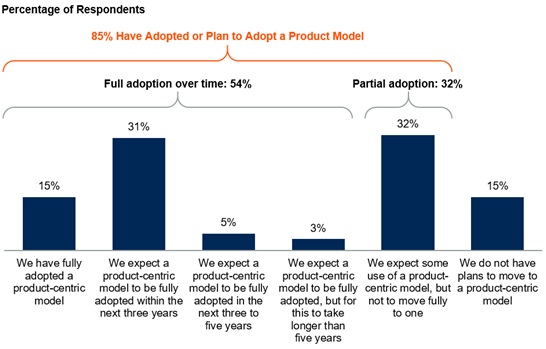“The increase in how quickly and broadly organizations are adopting the product-centric application model doesn’t arise randomly. It goes hand-in-hand with the adoption of agile development methodologies and DevOps,” said Bill Swanton, distinguished research vice president at Gartner. “In addition, an increasing number of applications that IT teams develop are used by external parties, such as clients or partners, and require the increased customer focus that characterises the product-centric model.”
The survey found that over half (54 per cent) of respondents expect to fully adopt the product-centric application model over time, while roughly one-third (32 per cent) plan partial adoption (see Figure 1). Managing everything as a product is unlikely to be justified, as some IT activities, such as initial implementation of a large software package, may well be better managed as projects.
Mr Swanton added: “Business leaders are generally unhappy with the speed at which they get application improvements and how they work. Given that no IT organisation gets anywhere near enough funding to do everything everyone wants when they want it, product-centric approaches allow faster delivery of the most important capabilities needed. They also force the business to prioritise the work, and to reprioritise it as requirements are better understood or the market changes.”
Speed to Market and Digital Business Motivate a Product-Centric Application Approach
Thirty-two per cent of the survey respondents identified a need to deliver more quickly as their main driver of adoption of a product-centric application approach. They said that speed to market was the main driver of their transformation process.
Digital business came second (31 per cent of respondents). When organisations start a digital transformation journey, they often find that traditional project methods are not suitable for the uncertainties of a transformative business model. They discover a need to adopt agile methods and to treat the results as products, since they will be used by external customers.
The shift from a project-centric to a product-centric application approach does not come without challenges, however. Concerns about project-based funding and the culture clash between “the business” and “IT” were the top challenges for 55 per cent of the respondents.
The Rise of the Product Manager Changes the Role of Application Leader
Forty-six per cent of the respondents said their organisation had already appointed a product manager, while 15 per cent plan to introduce this role by the end of 2018. Ten per cent have no plans to introduce this role.
According to the majority of respondents, product managers report, or will report, to the IT organisation or project management office. At the same time, respondents said they expect the role of application leader to change. For 43 per cent of respondents the role will reside in the IT organisation, while for 32 per cent it will migrate into business teams where the application leader will lead a product line or be a group or single product manager.
“As organisations gain more experience with product-centric delivery models, we expect product and technical leadership to separate from administrative line management. This will have an impact on the prospects of holders of the application leader role, who will need to choose between product management, engineering team management and administrative people management,” Mr Swanton said.




